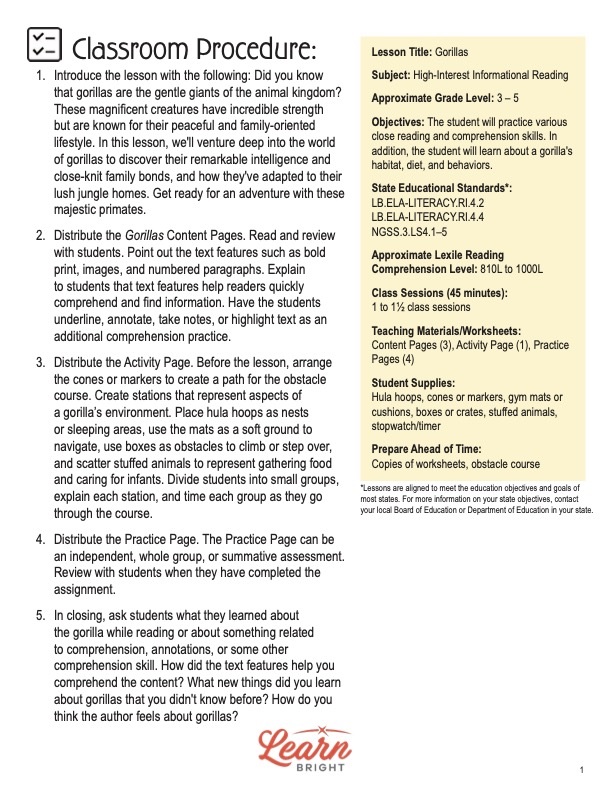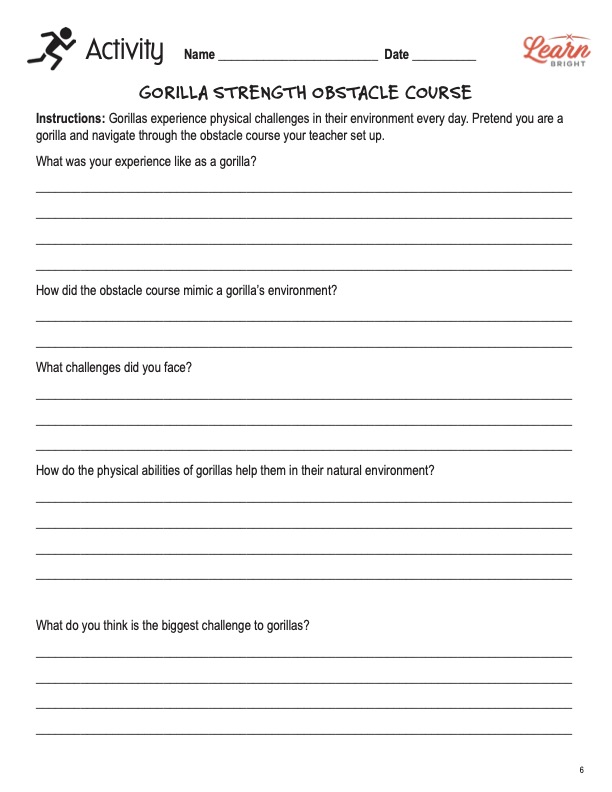Description
What our Gorillas lesson plan includes
Lesson Objectives and Overview: Gorillas is a high-interest reading comprehension lesson plan. As such, students will practice various close reading and comprehension skills. In addition, they will learn about the gorilla’s habitat, diet, and behaviors. This lesson is for students in 3rd grade, 4th grade, and 5th grade.
Classroom Procedure
Every lesson plan provides you with a classroom procedure page that outlines a step-by-step guide to follow. You do not have to follow the guide exactly. The guide helps you organize the lesson and details when to hand out worksheets. It also lists information in the yellow box that you might find useful. You will find the lesson objectives, state standards, and number of class sessions the lesson should take to complete in this area. In addition, it describes the supplies you will need as well as what and how you need to prepare beforehand. The activity in this lesson requires hula hoops, cones or markers, gym mats or cushions, boxes or crates, stuffed animals, and a stopwatch or timer.
Teacher Notes
The teacher notes page provides an extra paragraph of information to help guide the lesson and remind you what to focus on. It explains that you can teach this lesson in a whole-class setting or as an independent, small-group activity. The blank lines on this page are available for you to write out thoughts and ideas you have as you prepare the lesson.
GORILLAS LESSON PLAN CONTENT PAGES
What Is a Gorilla?
The Gorillas lesson plan contains three content pages. It begins by providing a box of background information about this animal. Gorillas are mammals that live in central Africa and mainly eat vegetation. They generally live between 35 and 40 years.
Gorillas are large, strong animals that live in central Africa’s dense forests. They have dark fur that helps them blend in with their surroundings. You can often see them with a patch of silver hair on their backs as they age. Gorillas are known for their impressive strength and big, muscular bodies. Their arms are longer than their legs, which helps them swing from tree branches.
These animals are very social, just like us! They live in groups called troops or families. A troop usually has a large, strong, male gorilla called a silverback because of his silver fur patch. The silverback is like the leader and protector of the troop. Alongside him, there are female gorillas and their babies. Silverbacks can weigh as much as 400 pounds (180 kilograms) or more, which is twice as heavy as female gorillas. The size and strength of the silverback help him maintain order within the troop and protect it from potential threats.
Gorillas are wonderful parents. They treat their young ones with a lot of care and love. Baby gorillas are called infants, and their moms are very protective of them. Moms carry their infants on their backs to keep them close. As the young gorillas grow, they learn essential things from their moms and the rest of the troop, such as what to eat and how to behave. This helps them grow up strong and prepares them to live on their own in the forest one day.
What Do They Eat?
It may surprise you to learn that gorillas are herbivores, so they eat plants and not meat. Their diet consists mainly of leaves, stems, shoots, and fruits. Scientists call them folivores because of how much they enjoy munching on the leaves of various trees and shrubs. One of their favorite foods is tender young leaves because soft leaves are easier to chew and digest. Gorillas are also known to eat some fruits that add a sweet and delicious treat to their diet. They use their strong jaws and sharp teeth to chew through the tough leaves and branches they find in their forest homes.
Because they are herbivores, gorillas are naturally foragers rather than hunters. This means they search for their food rather than chase it. Gorillas spend a lot of their time carefully selecting the best plants to eat. They rely heavily on their sense of sight and smell and use these keen senses to find tasty leaves and fruits. Once they locate a yummy plant, they use their strong hands and fingers to pluck the leaves or fruits from the trees and bushes. As foragers, they depend highly on the vegetation in their natural habitats.
Other Interesting Facts
Gorillas are part of the great ape family, and their scientific name is Gorilla gorilla. They are as strong as bulldozers. In fact, they are one of the strongest animals on the planet! They use their strong arms and hands to gather food and build comfortable nests for resting. This strength also helps them swing from tree branches and move through their thick forest homes. And, of course, it helps them protect the troop, maintain order, and defend their territory.
When it comes to hygiene, gorillas are experts at grooming each other. Grooming is when an animal carefully cleans the fur of other group members. Gorillas use their fingers to pick out dirt, leaves, and parasites (tiny bugs that can bother them) from each other’s fur. This grooming behavior serves several vital purposes.
First, it helps gorillas build and strengthen their social bonds. Just like when we hug or help someone, grooming allows gorillas to show affection and care for each other. Second, grooming also helps gorillas stay healthy and clean. By removing dirt and parasites from their fur, they can avoid infections and keep their coats in good condition.
Humans and gorillas have a lot in common. In fact, gorillas are our closest living relatives in the animal kingdom! We both belong to the same family, Hominidae. Gorillas have hands with opposable thumbs, so they can grasp objects and use tools, just like us. They have similar emotions and express happiness, sadness, and even playfulness. Some scientists study gorillas to learn more about our own behaviors and evolution. So, when you look into the eyes of a gorilla, you might see a little bit of yourself reflected back!
Why Gorillas Are Important to the Environment
Gorillas are incredibly important for the environment because they play a vital role in maintaining the health of the forests where they live. These big, gentle animals are seed dispersers, which means they help spread seeds from the fruits they eat. When they munch on fruits and later move around the forest, they unintentionally drop seeds in different places. The seeds then grow into new trees and plants, helping keep the forest diverse and healthy. Without gorillas, some plants might not be able to grow, and this could affect other animals that rely on these plants for food and shelter.
Sadly, gorillas are considered endangered, so there aren’t as many left in the wild. One of the main reasons for this is habitat loss. The forests gorillas live in are being cut down for things like logging and farming. Additionally, gorillas sometimes face threats from poaching, which is when people hunt them for their body parts or capture them to sell. Conservation efforts are crucial to protecting these amazing animals and their forest homes.
GORILLAS LESSON PLAN WORKSHEETS
The Gorillas lesson plan includes two worksheets: an activity worksheet and a practice worksheet. Each one will help students solidify their grasp of the material they learned throughout the lesson. You can refer to the classroom procedure guidelines to know when to hand out each worksheet.
GORILLA STRENGTH OBSTACLE COURSE
For this lesson, students will pretend to be gorillas as they navigate through an obstacle course. After they finish the obstacle course, they will answer five questions on the worksheet page.
GORILLAS PRACTICE WORKSHEET
The practice worksheet lists 11 questions based on the content. These questions all relate to the content pages, so students will need to refer to them often for the answers. In addition, each question provides which reading tool the question corresponds to, such as text feature, vocabulary, or comprehension.
Worksheet Answer Keys
At the end of the lesson plan document is an answer key for the practice worksheet. The correct answers are all in red to make it easier for you to compare them with students’ responses. If you choose to administer the lesson pages to your students via PDF, you will need to save a new file that omits these pages. Otherwise, you can simply print out the applicable pages and keep these as reference for yourself when grading assignments.










